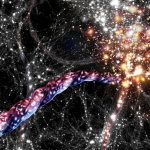- Astronomers have witnessed a star consuming a black hole, leading to a spectacular explosion and the birth of a new black hole.
- The event was first detected in 2017 by the Very Large Array (VLA) telescope, revealing a burst of energy comparable to a supernova.
- Follow-up observations at the Keck Observatory in Hawaii unveiled a luminous outflow of material, indicating a prior explosive event.
- Additional data from the MAXI telescope on the International Space Station confirmed an X-ray burst in the same location, dating back to 2014.
- This groundbreaking discovery sheds light on a rare cosmic phenomenon known as a merger-triggered core collapse supernova.
In an astonishing celestial revelation, astronomers have witnessed a celestial anomaly of cosmic proportions. For the very first time, a star has been observed consuming a dense celestial object, possibly a black hole or a neutron star. In a twist of fate, this object reciprocated by devouring the star’s core, culminating in a cataclysmic explosion, and leaving behind only a newly formed black hole.
The initial inklings of this extraordinary event were captured by the Very Large Array (VLA), an array of 27 colossal radio telescopes nestled in the New Mexican desert. During a routine sky scan in 2017, the VLA detected an exuberant burst of radio energy, rivaling the brilliance of a supernova, emanating from a dwarf star-forming galaxy located approximately 500 million light-years away.
Driven by this intriguing discovery, a team of astronomers led by Dillon Dong from Caltech embarked on a mission to unravel the cosmic enigma. They conducted follow-up observations of the galaxy, employing both the VLA and a telescope at the W.M. Keck Observatory in Hawaii, which perceives light in the same optical spectrum as the human eye. The Keck telescope unveiled a radiant outflow of matter expelling in all directions at a staggering speed of 3.2 million kilometers per hour from a central locus, indicating a previous high-energy explosion.
Upon delving into archival data from the Monitor of All Sky X-ray Image (MAXI) telescope, a Japanese instrument stationed on the International Space Station, the team uncovered an intensely luminous X-ray source. Astonishingly, this X-ray burst was precisely located at the same celestial coordinates as the earlier radio burst, albeit it had been recorded in 2014.
Compiling this wealth of data, Dong and his colleagues pieced together a plausible sequence of events. Eons ago, a binary star system was born, with two stars orbiting each other. One of them met a spectacular end in a supernova, transforming into either a neutron star or a black hole. Over time, gravitational forces inexorably drew the lifeless star into the outer layers of its larger, still-living companion.
This compact object spiraled within the living star for centuries, eventually reaching and devouring its partner’s core. Simultaneously, the larger star expelled copious amounts of gas and dust, forming a protective shell around the celestial pair. Deep within the living star’s core, intricate magnetic interactions and gravitational forces induced by the deceased star’s feeding frenzy gave rise to colossal jets of energy, manifested as an X-ray flare in 2014. Additionally, this tumultuous activity led to the ultimate demise of the larger star, triggering an explosive event. The resulting debris collided with the surrounding shell of matter, generating the observed optical and radio emissions.
Although theorists had previously envisioned such a scenario, known as a merger-triggered core collapse supernova, this represents the inaugural direct observation of this phenomenon. Adam Burrows, an astrophysicist at Princeton University, commended the team’s meticulous detective work. He highlighted that these findings hold the potential to refine our understanding of the common envelope evolution process, a brief yet crucial phase in the lives of stars, often challenging to witness or simulate. Typically, the engulfing star perishes before fully consuming the core, yielding two compact celestial objects in orbit, such as white dwarfs, neutron stars, or black holes.
Dong emphasized that the concluding phases of these systems align precisely with what observatories like the Advanced Laser Interferometer Gravitational-Wave Observatory (LIGO) detect when capturing the ripples in spacetime. With this newfound awareness, astronomers are poised to uncover more instances of this extraordinary cosmic spectacle, opening new avenues for exploration in the realm of celestial phenomena.


